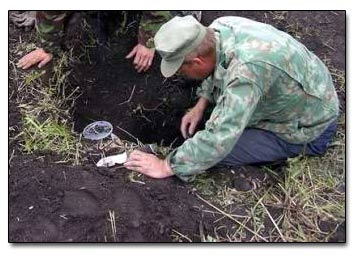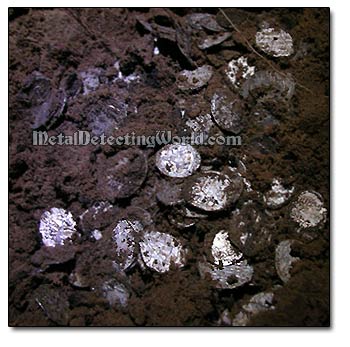Coin Cache Hunting - Search and Recovery Technique and Tips, page 2
Recovering a Coin Hoard in the Farm Field is a Thrill!

After the cache has been pinpointed, it is time to dig a prospecting pit. Its depth should be at least three shovel blades down, i.e. three layers of dirt would be taken out of the hole, one at a time.
The dimensions of the prospecting pit should be 3 ft by 3 ft. Before the dirt is taken out and scanned for more lose coins, you should prepare two spots, approximately 6 ft by 3 ft each, by scanning them for all junk signals with a metal detector.
The following procedure should be done by two persons. Two tarpaulins are placed at the spots that have been cleared of all junk signals. Now, one person takes the dirt of the first layer out of the pit and piles that dirt up onto the first tarpaulin. At the same time, the second person is transferring the dirt to the second tarpaulin, spreading the dirt in thin layer and slowly scanning it with a smaller search coil.
Before you take the dirt of a second layer out of the prospecting pit, you need to scan the side-walls of the prospecting pit with a metal detector because a few coins are usually "hang" in there at various depths.
If you get a few signals, you need to widen the prospecting pit until you don't get any signal at all. The dirt from the wall is also going onto the tarpaulin for scanning. Then, you repeat the procedures described above until and after you retrieve the cache's core.
If the cache was pinpointed correctly, it should be discovered before you hit the clay layer in the soil, depending on its geological conditions in the area. If you still have not found a cache' core, start digging another prospecting pit next to the one you have just dug. Rarely it takes only one hole to recover the entire hoard unless the buried treasure had been contained inside the pot (jug, box, jar, chest, etc).
Most of the time, a few prospecting pits have to be dug to find and retrieve the hoard's core, and to collect all the coins suspended in the soil around it. In some cases, when rare coins are involved, the prospecting pits should be dug everywhere within the coin-spread spot. That would assure you that all the coins were extracted from the ground.
This type of cache hunting requires a good physical shape and efficient teamwork. At least, two people should participate in the process. And here is one more thing... One of my fellow treasure hunters always performs the following ritual before and after searching for treasures at every location.
When he arrives at the metal detecting site, he makes a small hole in the ground and pours vodka into it while asking an imaginary old "grandpa" (who symbolizes the God of Metal Detecting) for his permission to search and dig the ground. At the end of metal detecting day, my friend thanks the "old-timer" while pouring vodka into a hole again before leaving the site.
Well, at least, this treasure hunter found a good use for the "Fire Water"... By the way, he started performing this ritual two years ago when he was flat broke. Now he is doing very well! Being a witness to the facts like this, it is hard not to be superstitious. :)
If you have any questions, see the FAQ's on my "Coin Cache Hunting" page.
Happy Cache Hunting!

Make a Donation
Please help me stay afloat, afford more metal detecting trips with field-tests and experiments to create more informative articles, useful tutorials and helpful guides for detectorists, and maintain this website - the most informative hobby resource on the web! Since I do not have any steady income, any donation matters to me a lot! Thank you kindly!
Clicking on the donate button will take you to a donation page powered by Donorbox and dedicated to my website (MetalDetectingWorld.com). The donation page is PCI-compliant, secured by SSL/TLS, and has a simple form to fill out. Donorbox does not store any card or bank data. Credit card information is encrypted and tokenized by the Stripe payment processor.
This website would not exist without the advertisements we display and your kind donations. If you are unable to support us by viewing our advertisements, please consider making a Donation to ensure the future of this website. By helping me keep this website alive and growing, you will sure help many detectorists around the world as well!
ANNOUNCEMENT:
In January of 2020, I started a one-time fund-raising campaign in attempt to accumulate enough money to buy a simple but reliable 4x4 vehicle. My old 4x4 car (made in 1995) had faithfully served me for 10 years before it eventually went beyond repair last October. Without a 4WD, I will not be able to get to my hunt sites and test-plots hidden in the remote wooded areas inaccessible by a regular car.
Unlucky for me, those sites are the only locations available and suitable for my field-work which results in informative articles you can find on this website. For the past 10 years, my usual field-work has consisted of field-testing the latest metal detectors and accessories, experimenting with some of them, and devising new effective search methods that meet the requirements of the new metal detecting reality.
Before my car died, I managed to finish a couple of interesting detector-testing projects which will be covered in my upcoming articles. But other equally important projects that I was working on were not completed and had to be postponed until the Spring 2020. I hope that this fund-raising campaign will help me get a decent 4x4 by then so that I will be able to resume my work and to write more new articles, tutorials and guides based on data gathered through testing and experimentation.
If you find my website useful and would like it to provide more essential info for you and other detectorists worldwide, please consider chipping in $5, $20, $50 or whatever you can afford to keep MetalDetectingWorld.com growing in 2020. I promise you, it will be money well spent. Thank you.
DonateBack to Detect Hammered Coins Index page
E-Trac and CTX-3030 Programs for Hammies
- Please help me promote this tutorial:
If you would like to follow me on Twitter, please press a button:
I have my profile page on
where you can share your thoughts on this tutorial, ask me a question, or place a friend request.I also have my profile pages on Pinterest, LinkedIn, Tumblr, Reddit and Delicious
and my "Metal Detecting World" page on Twitter, Pinterest and Tumblr
I no longer maintain my old Facebook page